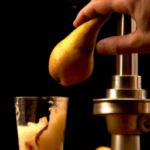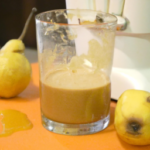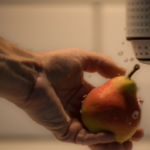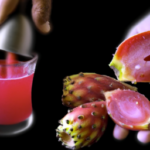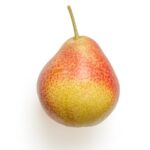Juice Tips and Tricks
How To Juice Pears

Juicing has become a popular way to incorporate more fruits and vegetables into our daily diets. It provides a simple and convenient way to get the necessary nutrients our bodies need while also satisfying our taste buds.
One fruit that is often overlooked in the juicing world is the pear. However, pears are a great addition to any juice blend, providing a sweet and refreshing flavor while also offering numerous health benefits.
Firstly, it’s important to note the many benefits of juicing pears. Pears are a great source of fiber, which can aid in digestion and promote feelings of fullness. They also contain antioxidants, which can help protect our cells from damage and reduce the risk of chronic diseases. Additionally, pears are a good source of vitamin C, which can boost our immune system and promote skin health.
By incorporating pears into our juice blends, we can reap all of these benefits while also enjoying a delicious and refreshing beverage.
Key Takeaways
- Pears are a great source of fiber, antioxidants, and vitamin C, making them a healthy addition to any juice.
- Complementary fruits and vegetables, such as apples, carrots, and ginger, can enhance the flavor and nutrition of pear juice.
- Using a masticating juicer at a low speed is recommended for juicing pears to prevent bitterness from the pear seeds.
- Properly storing fresh pear juice in the fridge can extend its shelf life up to 3 days.
Benefits of Juicing Pears
You’re going to love how juicing pears can give you an instant energy boost and improve your digestion! Pears are low in calories and high in fiber, making them a great addition to any juicing recipe. They’re also rich in vitamins and minerals, including vitamin C, vitamin K, and potassium.
Juicing pears can help you meet your daily nutritional requirements and give you a much-needed energy boost to power through your day. There are many delicious recipes that you can try when juicing pears. One of my favorites is a simple pear and ginger juice.
To make this recipe, simply blend together pears, ginger, and a bit of water until smooth. Not only is this juice delicious, but it’s also packed with nutrients that your body needs. So, if you’re looking for a healthy and tasty way to get your daily dose of vitamins and minerals, juicing pears is definitely worth trying!
Now, let’s move on to choosing the right pears for your juicing recipes.
Choosing the Right Pears
When selecting the perfect pear for juicing, it’s important to consider its ripeness, sweetness, and texture. Different pear varieties have varying degrees of sweetness and texture, so it’s important to know which type of pear is best for juicing. Some of the most popular pear varieties for juicing include Bartlett pears, Anjou pears, and Bosc pears.
The best time to buy pears for juicing is when they are fully ripe but not overripe. Look for pears that are slightly soft to the touch and have a sweet aroma. Avoid pears that are bruised or have soft spots, as they may not be suitable for juicing.
Once you have selected the perfect pears, it’s time to prepare them for juicing.
Preparing the Pears
To get your pears ready for the juicer, it’s time to start peeling and slicing them into manageable pieces. When it comes to peeling techniques, I prefer to use a vegetable peeler as it allows me to remove the skin with ease while also preserving as much of the flesh as possible. However, if you don’t have a peeler on hand, you can also use a knife to carefully remove the skin.
Once the pears are peeled, it’s important to slice them into pieces that will fit comfortably into your juicer. The ripeness of the pears will also play a role in how easy they are to slice. If the pears are too ripe, they may be too soft to slice without falling apart. On the other hand, if the pears are not ripe enough, they may be too hard to slice easily. To make the process easier, I recommend choosing pears that are slightly ripe, but still firm to the touch. With your pears sliced and ready to go, it’s time to move on to choosing additional ingredients to add to your juice.
Choosing Additional Ingredients
When choosing additional ingredients to add to my pear juice, I always consider complementary fruits and vegetables that will enhance the flavor and nutrition of the juice.
For example, adding apples or carrots can add natural sweetness, while adding spinach or kale can boost the antioxidant content.
I also like to experiment with herbs and spices, such as ginger or mint, to add a refreshing and aromatic touch to the juice.
Overall, selecting the right additional ingredients can elevate the taste and health benefits of my homemade pear juice.
Complementary Fruits and Vegetables
You’ll want to pair your pears with complementary fruits and vegetables to create a well-balanced and flavorful juice. Here are some pairing suggestions to help you get started.
-
Apples: Pears and apples are a classic combination that work well together in juice. They both have a similar texture and sweetness, and apples add a slightly tart flavor that complements the pear.
-
Carrots: Adding carrots to your pear juice will boost its nutritional value. Carrots are high in vitamin A and antioxidants, which can help improve your skin health and boost your immune system.
-
Ginger: If you want to add a little spice to your pear juice, try adding some ginger. Ginger can help improve digestion and reduce inflammation, making it a great addition to any juice.
Incorporating these complementary fruits and vegetables can add depth and complexity to your pear juice, making it a well-rounded and nutritious drink.
Moving on to the next section, let’s explore how herbs and spices can enhance the flavor of your pear juice even further.
Herbs and Spices
Now that we’ve discussed the importance of combining complementary fruits and vegetables, let’s move on to the use of herbs and spices in juicing.
Adding herbs and spices to your juice can not only enhance the flavor, but also provide numerous health benefits. For example, adding ginger to your pear juice can aid in digestion and reduce inflammation. Mint can have a calming effect on the digestive system and help with nausea. Turmeric is a powerful anti-inflammatory and can also boost the immune system.
These herbs and spices can easily be added to your juicer along with your pears and other fruits and vegetables for an added kick of flavor and health benefits.
As we continue to explore the world of juicing, let’s now move on to the techniques used to juice pears and other fruits.
Juicing Techniques
First, grab your juicer and quarter your pears to prepare for juicing. When it comes to juice extraction, using the right juicing equipment is key. I prefer using a masticating juicer as it’s known to preserve the nutrients and enzymes better than a centrifugal juicer. Additionally, make sure the juicer is set to a low speed to avoid heating the juice, which can also destroy nutrients.
Next, choose your juicing technique. One option is to juice the pears on their own, but you can also mix them with other fruits and vegetables to create a more complex flavor profile. For example, try adding ginger and lemon to your pear juice for a spicy kick. Or, mix in some kale and cucumber for added nutrients and freshness.
Once your juice is ready, you can adjust the flavor by adding some honey, cinnamon, or even a splash of apple cider vinegar. By adjusting the flavor, you can create a juice that’s perfectly suited to your taste preferences.
So, whether you prefer a sweet and fruity juice or something with a bit of a kick, don’t be afraid to experiment with different ingredients and flavors.
Adjusting the Flavor
To add some extra pizzazz to your pear juice, consider adjusting the sweetness and balancing the acidity. Pears are naturally sweet, but depending on the ripeness of the fruit and personal preference, you may want to adjust the sweetness level.
If your pears are not quite ripe yet, add a little bit of honey or maple syrup to sweeten things up. If your pears are very ripe and already quite sweet, you may want to balance the sweetness with a squeeze of lemon juice or a dash of cinnamon.
Additionally, if you find that your pear juice is a bit too acidic, you can balance it out with a little bit of sweetness. Again, honey or maple syrup are great options, but you can also try adding a pinch of salt or a few drops of vanilla extract.
Taste as you go and adjust as needed until you find the perfect balance of sweetness and acidity in your pear juice.
Next, let’s talk about how to store and serve your freshly juiced pear juice.
Storing and Serving
Now that I’ve successfully juiced my pears, it’s important to know how to store and serve them properly.
Refrigeration is the best option for storing fresh pear juice, as it can last up to 3 days. Freezing is also an option but note that the texture and flavor may slightly change.
When serving, I recommend adding a splash of lemon juice or ginger for extra flavor and garnishing with a slice of pear or a sprig of mint.
Refrigeration and Freezing
Refrigerating or freezing your pears is essential to maintain their quality and extend their shelf life. Proper storage can help avoid texture changes and spoilage, ensuring that your pears remain fresh and delicious for longer.
When refrigerating pears, place them in a plastic bag and store them in the crisper drawer. This will help prevent moisture loss and keep the fruit from becoming too soft.
If you want to freeze your pears, start by washing and peeling them. Cut them into slices or chunks and remove the seeds. Dip the pieces in a solution of water and lemon juice to prevent browning. Place the prepared pears in a freezer-safe container or bag and store them in the freezer. Frozen pears can last for up to 6 months and are perfect for smoothies or baking recipes.
When you’re ready to serve your pears, there are many different options to choose from. You can eat them as a snack, add them to salads or cheeseboards, or use them as a topping for oatmeal or yogurt. Pears also make a tasty addition to baked goods, such as pies, tarts, and muffins.
With so many possibilities, there’s no limit to the ways you can enjoy this sweet and versatile fruit.
Serving Suggestions
When serving your pears, you can impress your guests with the fact that over 95% of pears grown in North America are of the Bartlett variety, making it the most popular pear in the region. To make the presentation even more appealing, consider serving sliced pears on a decorative platter or arranging them in a fruit bowl. You can also add a pop of color by garnishing with fresh mint leaves or berries.
Here are some pairing suggestions to complement the juicy sweetness of your pear juice:
- Cheese: Pears pair well with a variety of cheeses, such as brie, gouda, or blue cheese. Serve a platter of cheese and pear slices for a sophisticated appetizer.
- Wine: A crisp white wine, such as Sauvignon Blanc or Pinot Grigio, is a great match for the delicate flavors of pears. For a sweeter option, try a Riesling or Moscato.
Now that your guests have enjoyed their refreshing pear juice and complementary pairings, it’s time to clean up and prepare for the next course.
Cleaning Up
Ready to enjoy your deliciously fresh pear juice? Before you start sipping, don’t forget to give your juicer a thorough cleaning to keep it in tip-top shape for your next juicing adventure! Here are some clean-up tips to help you maintain your juicer:
First, unplug your juicer and disassemble it. Rinse all the parts under running water to remove any pear residue. Use a soft brush to scrub any hard-to-reach areas.
Make sure to clean the mesh strainer thoroughly, as it can easily get clogged with pulp. Once you’ve cleaned all the parts, dry them with a clean towel before reassembling your juicer.
Dispose of any leftover pear scraps in a compost bin or trash can.
Now that your juicer is all clean, it’s time for some tips and tricks to help you get the most out of your pear juice.
Tips and Tricks
When juicing pears, there are a few tips and tricks that I’ve found useful in maximizing yield and avoiding bitterness.
First, make sure to choose ripe pears that are soft to the touch but not mushy. This will ensure the sweetest and most flavorful juice.
Second, I recommend using a slow juicer rather than a centrifugal juicer to prevent bitterness from the pear seeds.
Finally, if you do notice any bitterness, try adding a small piece of ginger or lemon to balance it out.
Maximizing Yield
To get the most juice out of your pears, try squeezing them with a cheesecloth or using a juicer. Here are some tips to help you maximize your yield:
-
Use ripe pears: Ripe pears contain more juice than unripe ones. Choose pears that are slightly soft to the touch and have a sweet aroma.
-
Cut them into small pieces: Smaller pieces are easier to juice than larger ones. Cut your pears into small chunks or thin slices before juicing.
-
Press the pulp: After juicing, use a spoon to press down on the pulp and extract any remaining juice.
-
Use leftover pulp: Don’t throw away the leftover pulp! It can be used in a variety of ways, such as adding it to smoothies or using it to make pear sauce.
-
Try DIY pear juice without a juicer: If you don’t have a juicer, you can still make pear juice by blending the pears with a little water and straining the mixture through a fine-mesh sieve or cheesecloth.
By following these tips, you can get the most juice out of your pears and reduce waste.
Next, let’s talk about how to avoid bitterness in your pear juice.
Avoiding Bitterness
If you’ve ever tasted bitter pear juice, you know how disappointing it can be. One way to avoid this is to choose the right pear variety. Certain varieties, like Bartlett and Anjou, are sweeter and less likely to produce bitter juice. On the other hand, Bosc and Comice pears are more prone to bitterness.
Additionally, make sure to use ripe pears for juicing. Unripe pears contain more tannins, which can cause bitterness. Another way to avoid bitterness in pear juice is to cook it. Cooking breaks down the tannins and reduces their bitterness. This also adds a depth of flavor to the juice.
You can use cooked pear juice in a variety of recipes, from cocktails to marinades. When cooking pear juice, start by simmering it over low heat until it reduces by half. This concentrates the flavors and reduces the bitterness. Then, let the juice cool and strain it before using it in your recipe.
Frequently Asked Questions
Can you use canned pears for juicing?
Yes, canned pears can be used for juicing, but fresh pears are more nutritious. Canned pears lose some of their nutritional value during processing and may contain added sugars.
Is it necessary to peel the pears before juicing?
To peel or not to peel? While the skin of pears contains valuable nutrients like fiber and antioxidants, it can also contain pesticides or wax. Ultimately, peeling is optional and depends on personal preference and quality of the fruit.
How many pears do I need to make a glass of juice?
To make a glass of pear juice, I usually juice about 3-4 medium-sized pears. As for pairing flavors, ginger and lemon complement the sweetness of pear juice and add a little kick to the taste.
Can I mix pears with other fruits or vegetables in my juice?
Yes, mixing pears with other fruits or vegetables can enhance the flavor and nutritional value of your juice. However, pear juice alone has many benefits, including aiding digestion and promoting heart health. The best time to drink pear juice is in the morning on an empty stomach.
How long can I store pear juice in the refrigerator?
Storing pear juice in the refrigerator is a great option, but it’s important to consume it within 2-3 days. Alternatively, freezing the juice in ice cube trays or airtight containers can extend its shelf life. Pear juice is also rich in antioxidants, making it great for maintaining healthy skin.
Conclusion
Overall, juicing pears is a delicious and nutritious way to incorporate more fruits into your diet. Not only do pears provide a sweet and refreshing taste, but they also offer a variety of health benefits such as aiding digestion and promoting heart health.
By following the steps outlined in this article, you can easily juice pears at home and experiment with different flavor combinations to find your perfect blend.
One potential concern with juicing pears is the sugar content. While pears do contain natural sugars, they’re low on the glycemic index and won’t cause spikes in blood sugar levels like processed sugars do. Additionally, juicing allows for the removal of the fiber in the fruit, which can help slow down the absorption of sugar into the bloodstream.
As with any food or drink, moderation is key, but don’t let concerns about sugar content deter you from enjoying the delicious and nutritious benefits of juicing pears.
Cindy thoroughly researches juicing trends, techniques, and recipes to provide readers with practical advice and inspiration. Her writing style is accessible, engaging, and designed to make complex concepts easy to understand. Cindy’s dedication to promoting the advantages of juicing shines through her work, empowering readers to make positive changes in their lives through the simple act of juicing.
Juice Tips and Tricks
How to Make Aloe Vera Juice Taste Better

Tired of the strong flavor of aloe vera juice? No problem, we’ve got the answer for you.
In this article, we’ll share some tips and tricks to make your aloe vera juice taste better. We have tried and tested various methods to enhance the flavor without compromising the health benefits.
From choosing the right juice to adding natural sweeteners and infusing with fruits and herbs, we’ve got all the information you need to transform your aloe vera juice into a delightful and refreshing beverage.
Let’s dive in!
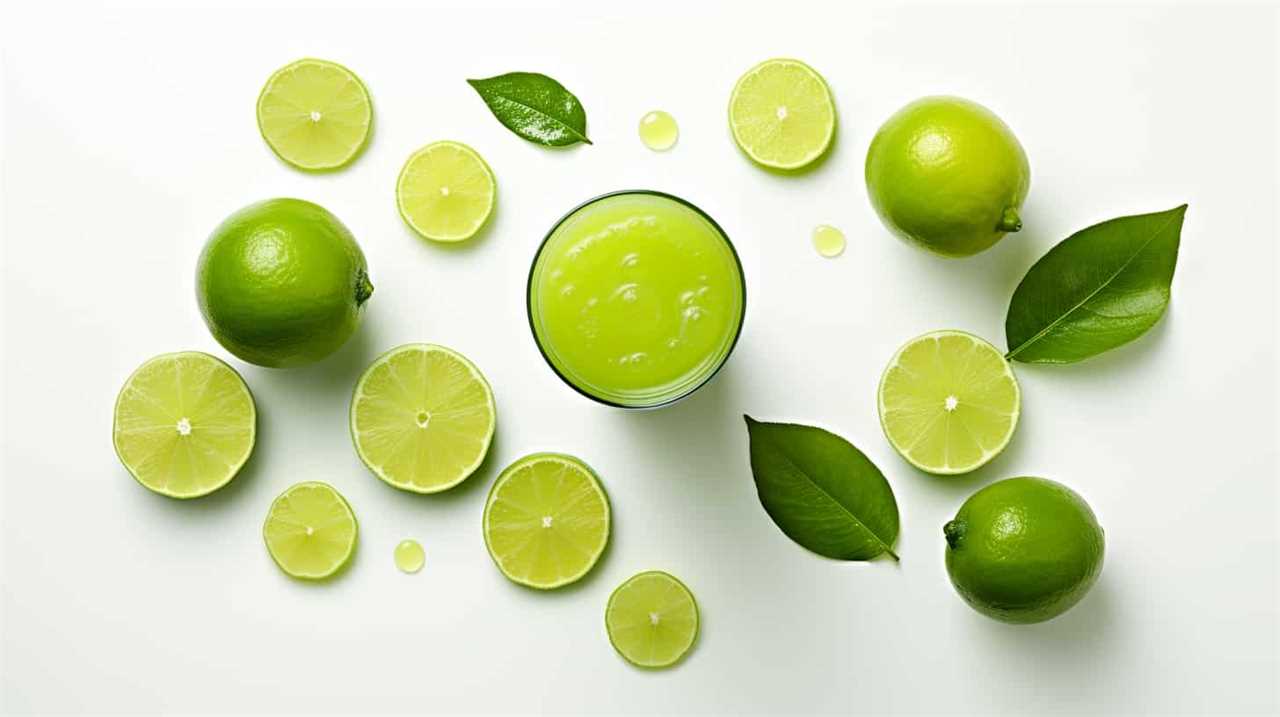
Key Takeaways
- Choose a reputable brand of aloe vera juice that prioritizes quality and uses organic, pure aloe vera.
- Avoid brands that contain added sugars or artificial ingredients.
- Use natural sweeteners like honey, agave syrup, or stevia to enhance the taste of aloe vera juice.
- Experiment with adding fruits, herbs, and other juices to create unique flavor combinations and enhance the health benefits of aloe vera juice.
Choosing the Right Aloe Vera Juice
We can enhance our experience with aloe vera juice by selecting the right brand and type for our preferences. When it comes to finding a reputable brand, it’s important to do some research and read reviews from other consumers. Look for brands that prioritize quality and use organic, pure aloe vera without any added sugars or artificial ingredients. Understanding the health benefits of aloe vera juice is also crucial in making the right choice. Aloe vera is known for its soothing properties, aiding digestion, promoting skin health, and boosting the immune system. By choosing a high-quality brand, we can ensure that we’re getting the maximum benefits from our aloe vera juice.
Now that we know how to choose the right brand, let’s move on to the next step of adding natural sweeteners.
Adding Natural Sweeteners
To enhance the flavor of our aloe vera juice, we can add natural sweeteners such as honey or agave syrup. Using alternative sweeteners not only adds sweetness but also brings unique flavors to the juice. Here are some options to consider:
- Stevia: A natural sweetener derived from the Stevia plant, it’s a zero-calorie alternative to sugar.
- Maple Syrup: This natural sweetener adds a rich and earthy flavor to the aloe vera juice.
- Dates: Pureed dates can be used to sweeten the juice while also providing essential nutrients like fiber.
In addition to using alternative sweeteners, we can enhance the flavor of aloe vera juice by adding spices and extracts. Cinnamon, ginger, or vanilla extract can add warmth and depth to the taste. By experimenting with different combinations of these natural sweeteners, spices, and extracts, we can create a flavor profile that suits our preferences.
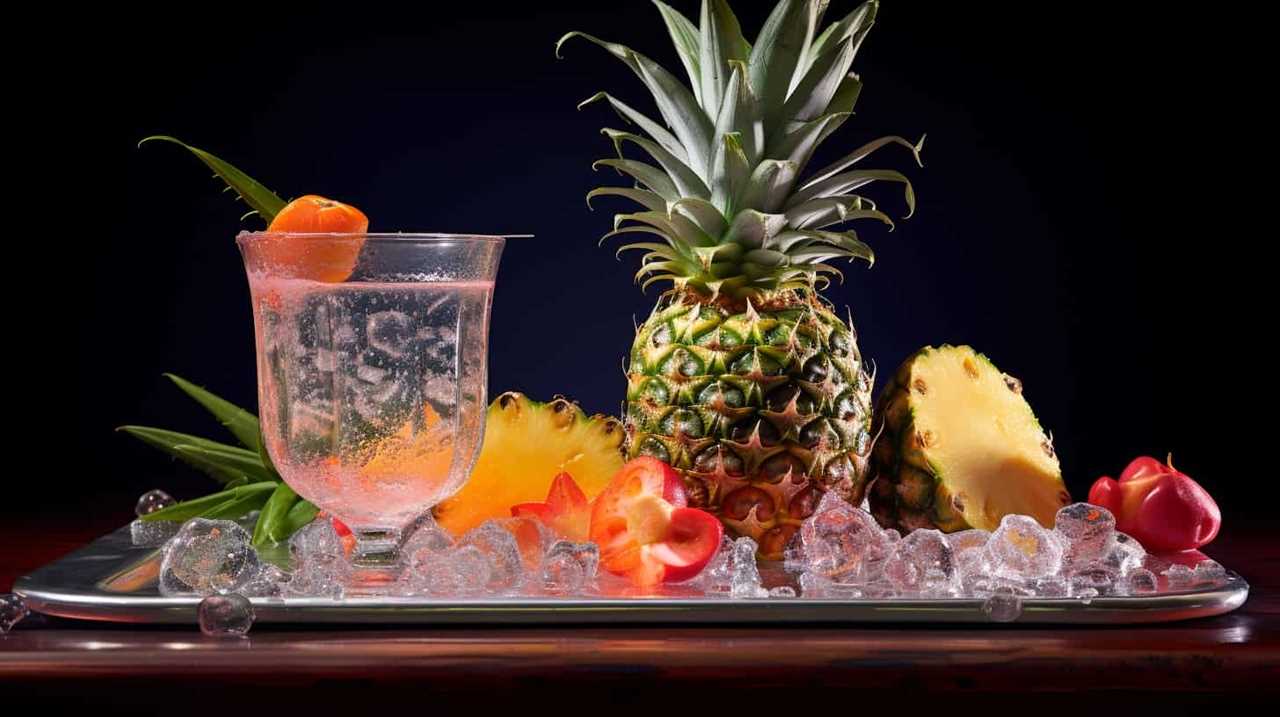
Now, let’s move on to the next section and learn how to infuse aloe vera juice with fruits and herbs to further enhance its taste.
Infusing With Fruits and Herbs
As we explore ways to make our aloe vera juice taste better, one option to consider is infusing it with fruits and herbs. Creating unique aloe vera blends by adding fruits and herbs not only enhances the flavor but also adds a touch of freshness and complexity to the juice.
Fruits like strawberries, pineapple, or citrus can add a burst of sweetness, while herbs like mint, basil, or ginger can provide a subtle yet refreshing twist. Exploring the benefits of herbal infusions can also be beneficial for our health. For example, adding a few sprigs of lavender can promote relaxation and reduce stress. Additionally, infusing aloe vera juice with rosemary can aid digestion and boost the immune system.
Blending With Other Juices
Let’s try mixing aloe vera juice with different fruit juices to create delicious and refreshing blends. Blending aloe vera juice with other fruits not only enhances its taste but also adds nutritional benefits to your drink. Here are three fruit juices that you can mix with aloe vera juice:

- Orange juice: Combining aloe vera juice with orange juice not only adds a tangy flavor but also boosts your intake of vitamin C, which is essential for a strong immune system.
- Pineapple juice: Mixing aloe vera juice with pineapple juice creates a tropical blend that isn’t only refreshing but also helps in digestion. Pineapple contains bromelain, an enzyme that aids in breaking down proteins and promoting better digestion.
- Watermelon juice: Blending aloe vera juice with watermelon juice creates a hydrating and refreshing combination. Watermelon is rich in water content and contains electrolytes that can help replenish your body’s fluids.
Experimenting With Flavor Combinations
While we can try various flavor combinations with aloe vera juice, it’s important to find the right balance to enhance its taste. Experimenting with different flavors can’t only make the juice more enjoyable but also enhance its health benefits.
Aloe vera juice is known for its numerous health benefits, such as boosting digestion, promoting hydration, and supporting the immune system. By adding complementary flavors, we can create a refreshing summer drink that not only tastes great but also provides a nutritional boost.
Some popular flavor combinations include mixing aloe vera juice with citrus fruits like lemon or orange, adding a splash of coconut water for a tropical twist, or combining it with cucumber and mint for a refreshing and cooling effect.
Don’t be afraid to get creative and find the flavor combination that suits your taste buds best!
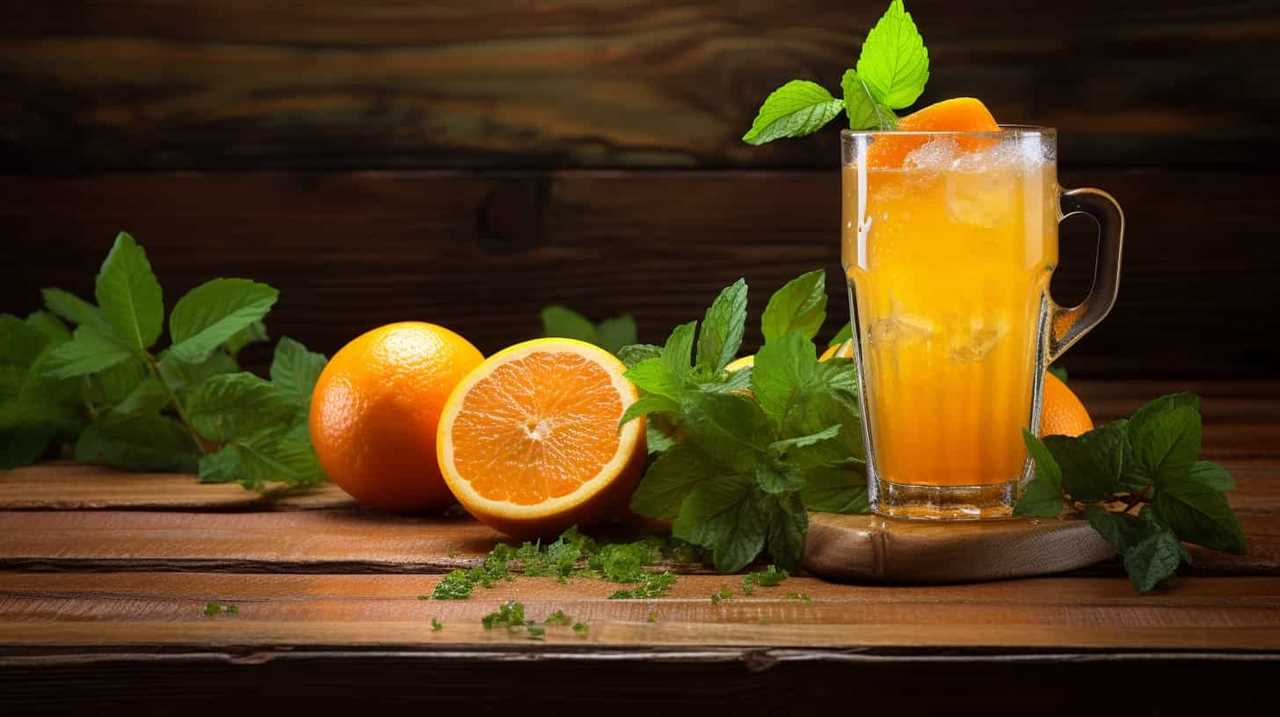
Frequently Asked Questions
Can I Use Store-Bought Aloe Vera Gel Instead of Fresh Aloe Vera for Making Juice?
Yes, you can use store-bought aloe vera gel instead of fresh aloe vera for making juice. However, it’s important to note that fresh aloe vera juice may have more health benefits due to its higher nutrient content.
How Long Can I Store Aloe Vera Juice in the Refrigerator?
Aloe vera juice can be stored in the refrigerator for up to a week. Refrigeration helps maintain the longevity and freshness of the juice, preserving its beneficial properties.
Can Aloe Vera Juice Help With Digestive Issues?
Aloe vera juice can potentially help with digestive issues when taken in appropriate dosages. However, it is important to note that there may be potential side effects. It is always best to consult with a healthcare professional before starting any new supplement regimen.
Can I Use Artificial Sweeteners Instead of Natural Sweeteners in My Aloe Vera Juice?
Using artificial sweeteners in aloe vera juice may affect its taste and potential health benefits. However, natural sweeteners like honey or stevia can enhance the flavor without compromising its nutritional value.

Is It Safe to Drink Aloe Vera Juice Every Day?
Drinking aloe vera juice daily can have numerous benefits, such as improving digestion and boosting the immune system. However, consuming it regularly may also lead to potential side effects like diarrhea or stomach cramps.
Conclusion
In conclusion, making aloe vera juice taste better is easy and enjoyable.
By choosing the right aloe vera juice and adding natural sweeteners, infusing with fruits and herbs, blending with other juices, and experimenting with flavor combinations, you can create a delightful and refreshing drink.
So go ahead and unleash your creativity in the kitchen, and transform your aloe vera juice into a sensational elixir that will transport your taste buds to paradise.
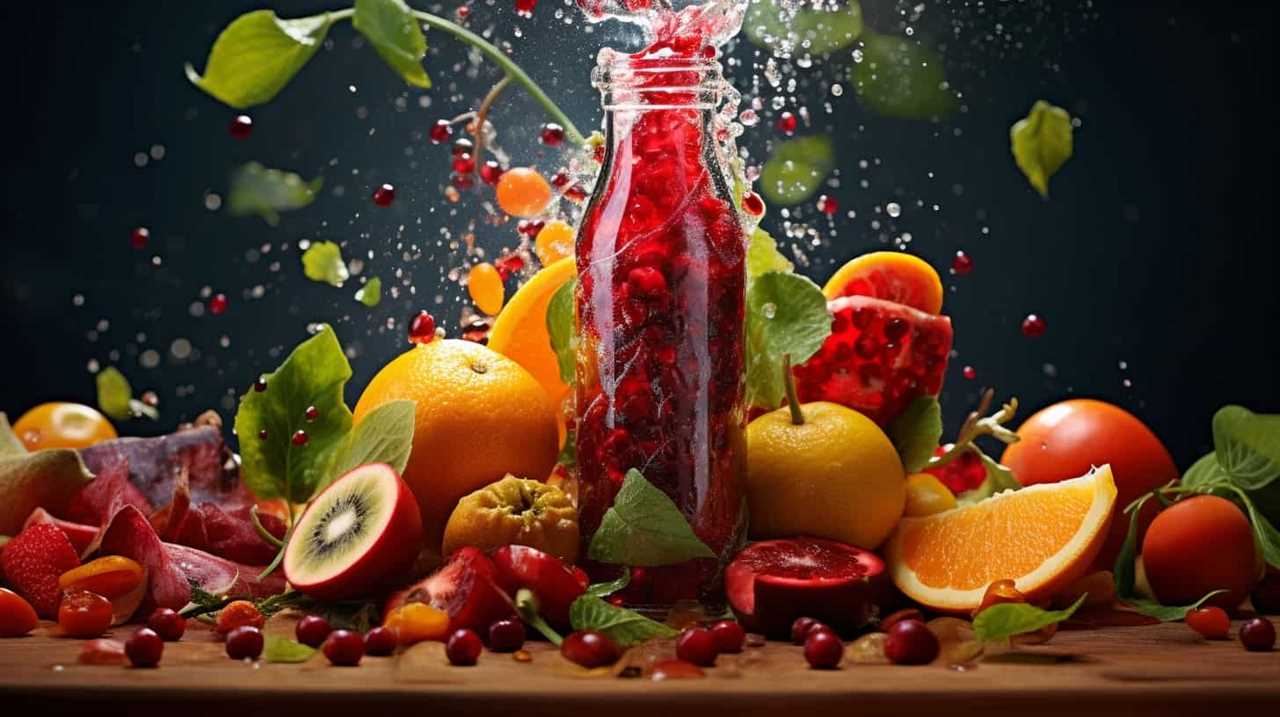
Susannah expertise lies in researching and compiling evidence-based content on juicing, nutrition, and overall health. She is committed to ensuring that The Juicery World offers accurate, up-to-date, and trustworthy information to empower readers to take control of their health. Susannah’s goal is to inspire individuals to embrace juicing as a way to nourish their bodies and live their best lives.
Juice Tips and Tricks
How to Make a Glass of Lemonade With Bottled Lemon Juice

Are you craving a cool glass of lemonade to quench your thirst? Look no further! Try out our perfect recipe using bottled lemon juice that will surely please your taste buds.
In this article, we’ll guide you through the process of creating a tangy and sweet concoction that will leave you feeling refreshed and satisfied.
So grab your ingredients and let’s get started on this delightful journey of serving ourselves and others a glass of pure lemony goodness.
Key Takeaways
- Consider the storage of the bottled lemon juice (dark glass or plastic bottles, protect from light exposure, check expiration date)
- Choose a suitable pitcher and fresh lemons for enhanced flavor
- Store the lemonade concentrate in the refrigerator to maintain freshness
- Adjust the sweetness and tartness to taste with sugar or more lemon juice, and experiment with different sweeteners or additional flavors.
Choosing the Right Bottled Lemon Juice
What are the key factors we should consider when selecting the right bottled lemon juice for our lemonade?

One important factor is how the lemon juice is stored. Look for bottles that are made of dark glass or plastic, as they help protect the juice from light exposure, which can degrade its quality. It’s also important to check the expiration date to ensure freshness.
Another benefit of using bottled lemon juice is convenience. It saves time and effort compared to squeezing fresh lemons. Additionally, bottled lemon juice provides consistent flavor, as the acidity levels are standardized.
When selecting a brand, consider reading reviews and checking for certifications, such as organic or non-GMO.
Gathering the Necessary Ingredients and Tools
How can we gather all the necessary ingredients and tools to make a glass of lemonade with bottled lemon juice?
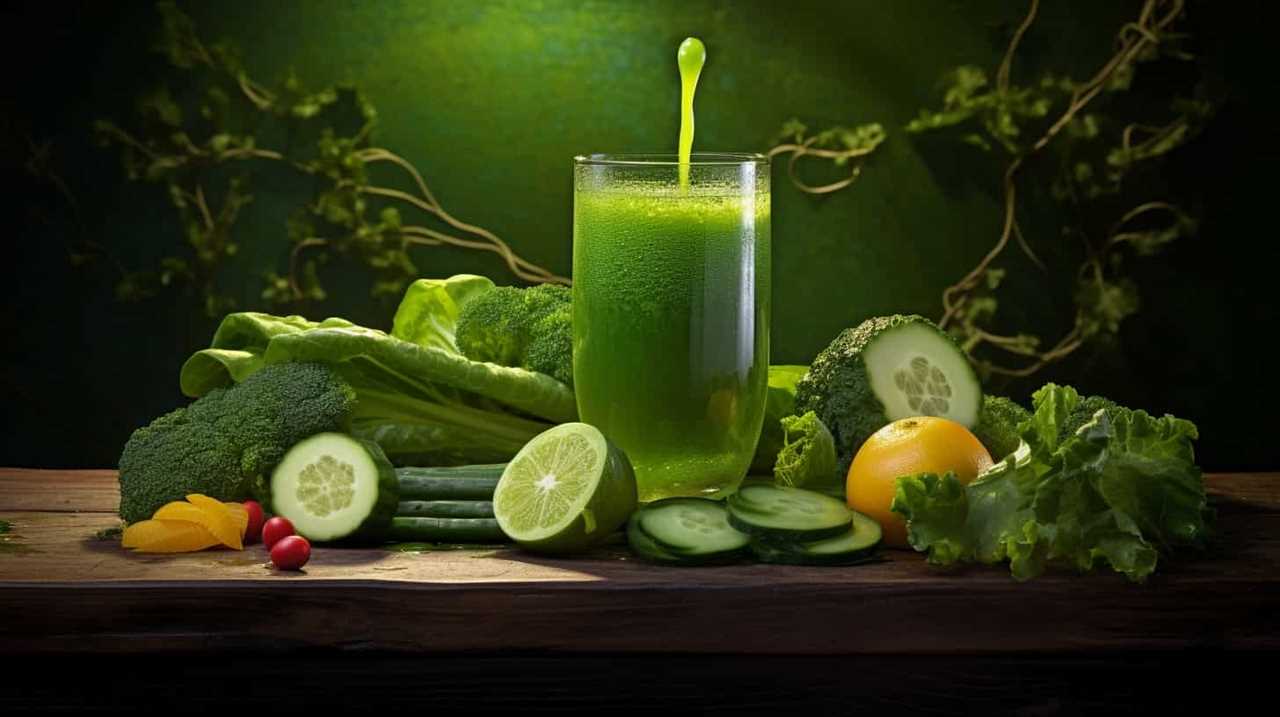
It’s important to start with the right pitcher. Look for a pitcher that’s made of glass or BPA-free plastic, as these materials won’t affect the taste of the lemonade. The pitcher should also have a lid or cover to keep the lemonade fresh and prevent spills.
Now, let’s talk about the lemons. While bottled lemon juice is convenient, using fresh lemons instead can elevate the flavor of your lemonade. Choose lemons that are firm and have a bright yellow color. Give them a gentle squeeze to ensure they’re juicy. To extract the juice, you’ll need a citrus juicer or a reamer. These tools make it easy to get every last drop of juice from the lemons.
Mixing the Lemonade Concentrate
To start mixing the lemonade concentrate, we’ll slowly pour the bottled lemon juice into the pitcher. It’s important to choose the right container for the lemonade concentrate. A pitcher with a lid or a tightly sealed container will help maintain the freshness and prevent any spills or leaks. Once the lemon juice is in the pitcher, we can move on to the next step of adding water and sweetener.
To ensure the lemonade concentrate stays fresh, it’s essential to store it properly. Keep the pitcher in the refrigerator to maintain its cool temperature and prevent any bacteria growth. If you have any leftover concentrate, transfer it to a smaller container with an airtight lid before refrigerating. This will help retain its flavor and prevent any contamination.
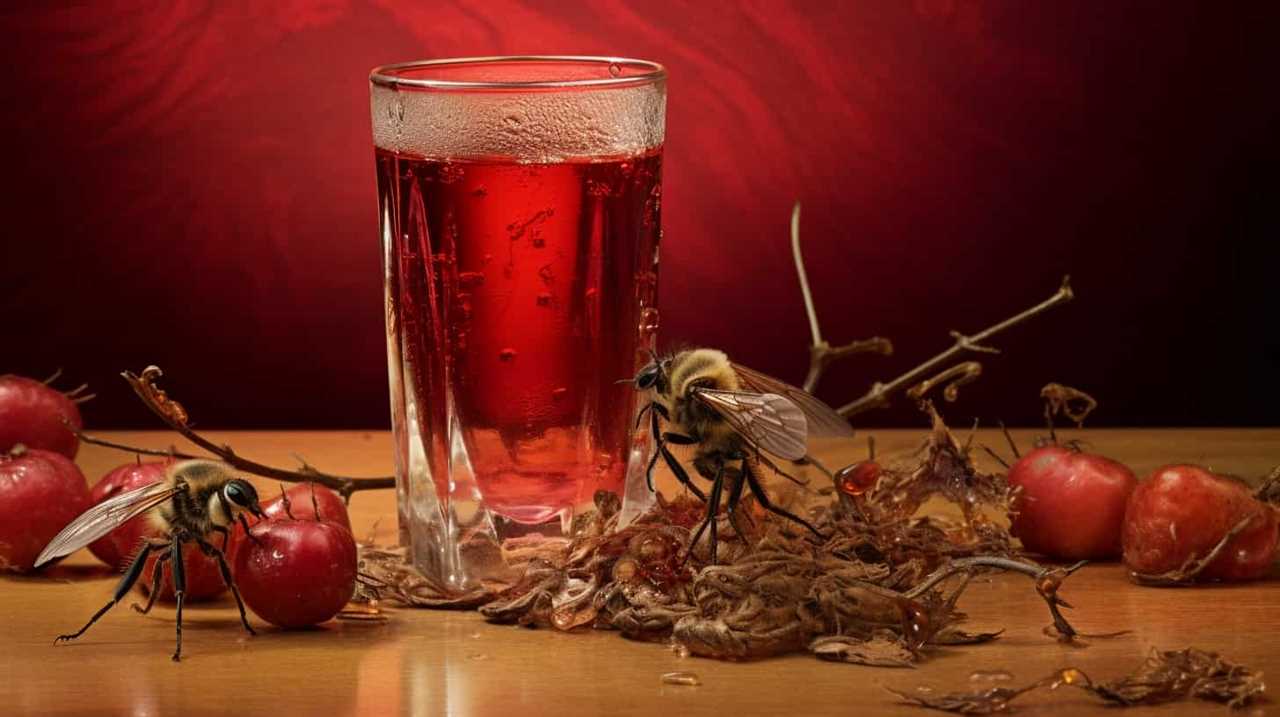
Now that we’ve mixed the lemonade concentrate, it’s time to adjust the sweetness and tartness to taste.
Adjusting the Sweetness and Tartness to Taste
We can adjust the sweetness and tartness of the lemonade to taste by adding more sugar or lemon juice, respectively. If you prefer a sweeter lemonade, simply add more sugar and stir until it dissolves completely. You can experiment with different sweeteners such as honey or agave syrup to find the perfect balance of sweetness.
On the other hand, if you want a tangier lemonade, add more lemon juice gradually, tasting as you go until it reaches your desired level of tartness.
Additionally, you can get creative with your lemonade by adding flavors like fresh mint leaves or a hint of lavender. These additions can elevate the flavor profile and create a more refreshing and unique experience.
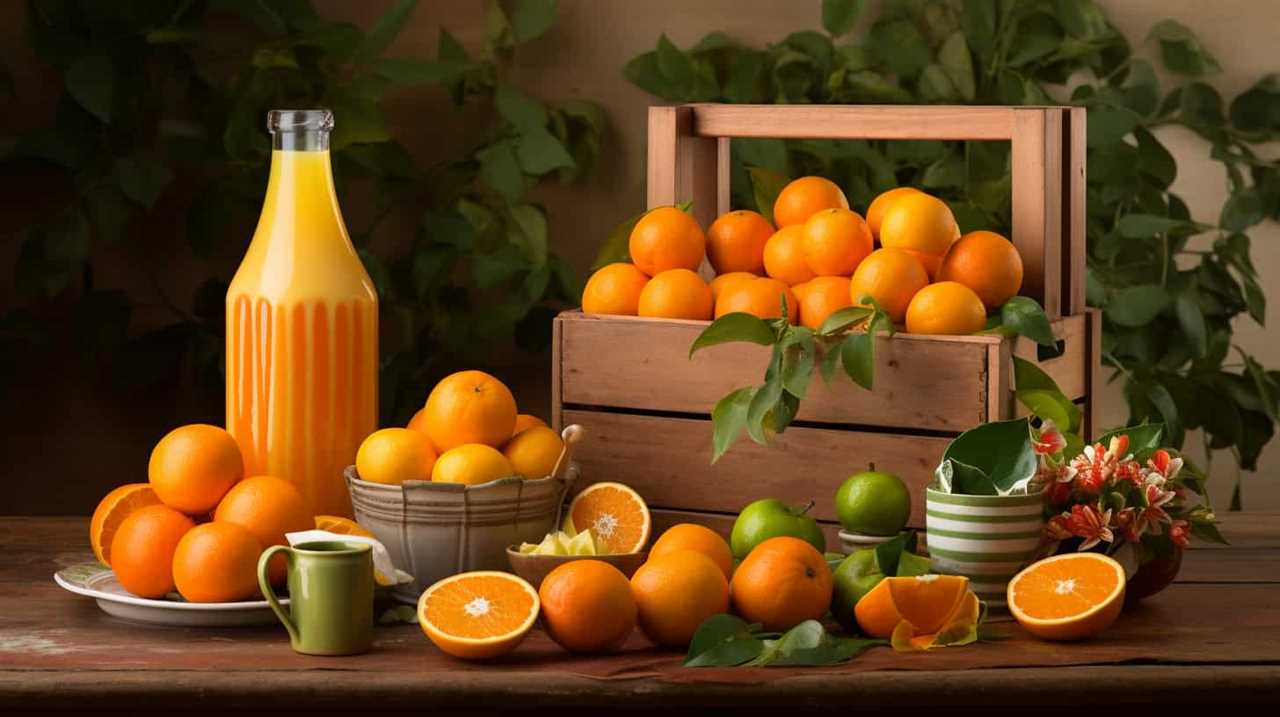
Now that we’ve adjusted the sweetness and tartness of our lemonade, let’s move on to serving and enjoying your refreshing glass of lemonade.
Serving and Enjoying Your Refreshing Glass of Lemonade
Now let’s sit back, relax, and savor our refreshing glass of lemonade.
When it comes to serving and enjoying this delightful drink, there are a few techniques and garnishing options to consider.
Firstly, serving your lemonade chilled is essential for maximum enjoyment. Ensure that you have chilled glasses or add ice cubes to the glasses before pouring the lemonade.

To add a touch of elegance, you can garnish your lemonade with a slice of lemon on the rim of the glass. For an extra burst of flavor, you could also add a sprig of fresh mint or a few berries.
Remember to gently stir the lemonade before serving to evenly distribute the flavors.
Now, take a sip, feel the refreshing tang of lemon, and let the sweet and tart flavors dance on your taste buds.
Cheers!
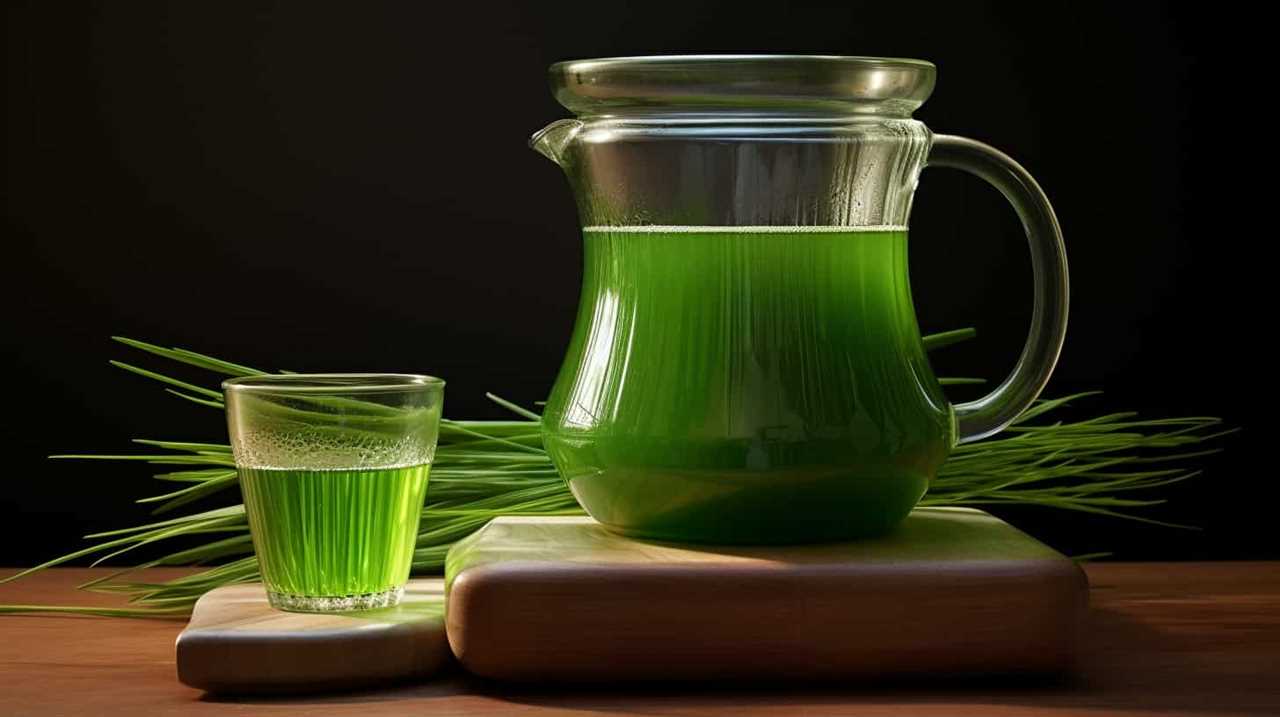
Frequently Asked Questions
Can I Use Fresh Lemons Instead of Bottled Lemon Juice?
Fresh lemons offer numerous benefits over bottled lemon juice. The taste of fresh lemons is unparalleled, providing a vibrant and tangy flavor. Incorporating fresh lemons into your lemonade will elevate its taste and give it a refreshing and authentic twist.
Can I Substitute Sugar With a Different Sweetener?
Substituting sweeteners in lemonade can enhance the flavor and offer health benefits. We’re knowledgeable about alternative sweeteners and can provide precise, detailed instructions on using them in place of sugar.
How Long Does the Lemonade Concentrate Need to Chill in the Refrigerator?
The chilling time for the lemonade concentrate in the refrigerator is typically around 1-2 hours. Using bottled lemon juice offers the benefit of convenience and consistent flavor for a refreshing glass of lemonade.
Can I Add Other Fruits or Flavors to the Lemonade?
Sure, we can definitely add different fruits or flavors to our lemonade. It’s a great way to experiment with unique flavors and create refreshing, personalized drinks. The possibilities are endless!

How Long Does the Lemonade Stay Fresh in the Refrigerator?
Lemonade made with bottled lemon juice can stay fresh in the refrigerator for about 5-7 days. To maximize shelf life, store it in an airtight container and keep it chilled.
Conclusion
And so, with a few simple steps and the right ingredients, a glass of refreshing lemonade is born.
Like a symphony of flavors dancing on your taste buds, this tangy elixir quenches thirst and brings joy on a hot summer day.
Just a sip transports you to a world of citrusy delight, where the sweetness and tartness blend harmoniously.

So go ahead, indulge in the art of lemonade-making and savor every drop of this sun-kissed nectar.
Cheers to the perfect glass of lemonade!
Susannah expertise lies in researching and compiling evidence-based content on juicing, nutrition, and overall health. She is committed to ensuring that The Juicery World offers accurate, up-to-date, and trustworthy information to empower readers to take control of their health. Susannah’s goal is to inspire individuals to embrace juicing as a way to nourish their bodies and live their best lives.
Juice Tips and Tricks
How to Know if Orange Juice Is Bad

We’ve all been in that situation before – reaching for a glass of orange juice and hesitating, unsure if it’s still okay to drink. Fear not! This article will give you the knowledge you need to determine for sure if your orange juice is still fresh or if it’s gone bad.
With a blend of scientific precision and practical tips, we’ll explore color changes, strange smells, off taste, texture changes, and mold or growth that may indicate spoilage.
Let’s dive in and serve ourselves a refreshing glass of certainty!
Key Takeaways
- Color changes in orange juice can indicate a loss of freshness and shelf life extension, but it doesn’t necessarily mean the juice is bad.
- Unusual or off-putting odors in orange juice, such as sour or fermented scents, can be a sign of poor quality.
- An off taste in orange juice, such as sour, bitter, or fermented flavors, suggests that the juice is spoiled.
- Texture changes in orange juice, such as pulp separation or a thicker consistency, can occur as the juice ages, so it’s important to consume it before the expiration date.
Color Changes in Orange Juice
We should be aware that color changes can indicate whether orange juice is bad.

When it comes to orange juice, color is a crucial factor to consider. As oranges are exposed to air, an oxidation process occurs, which leads to changes in color. Fresh orange juice has a vibrant orange hue, indicating its freshness and high nutritional value.
However, as time passes, the juice may undergo a color change, turning dull or brownish. This change in color is a result of the oxidation process, which affects the flavor and quality of the juice. It’s important to note that while a change in color doesn’t necessarily mean the juice is bad, it does indicate that the juice is losing its freshness and shelf life extension.
Therefore, it’s advisable to consume orange juice when it’s at its freshest, as indicated by its vibrant orange color.
Strange Smells in Orange Juice
When it comes to evaluating orange juice, we should be cautious of any strange smells or odors. A fresh, pleasant smell is indicative of good quality orange juice. However, if you notice any unusual or off-putting odors, it may be a sign that the juice has gone bad. These smells can range from a sour or fermented scent to a rancid or moldy aroma.
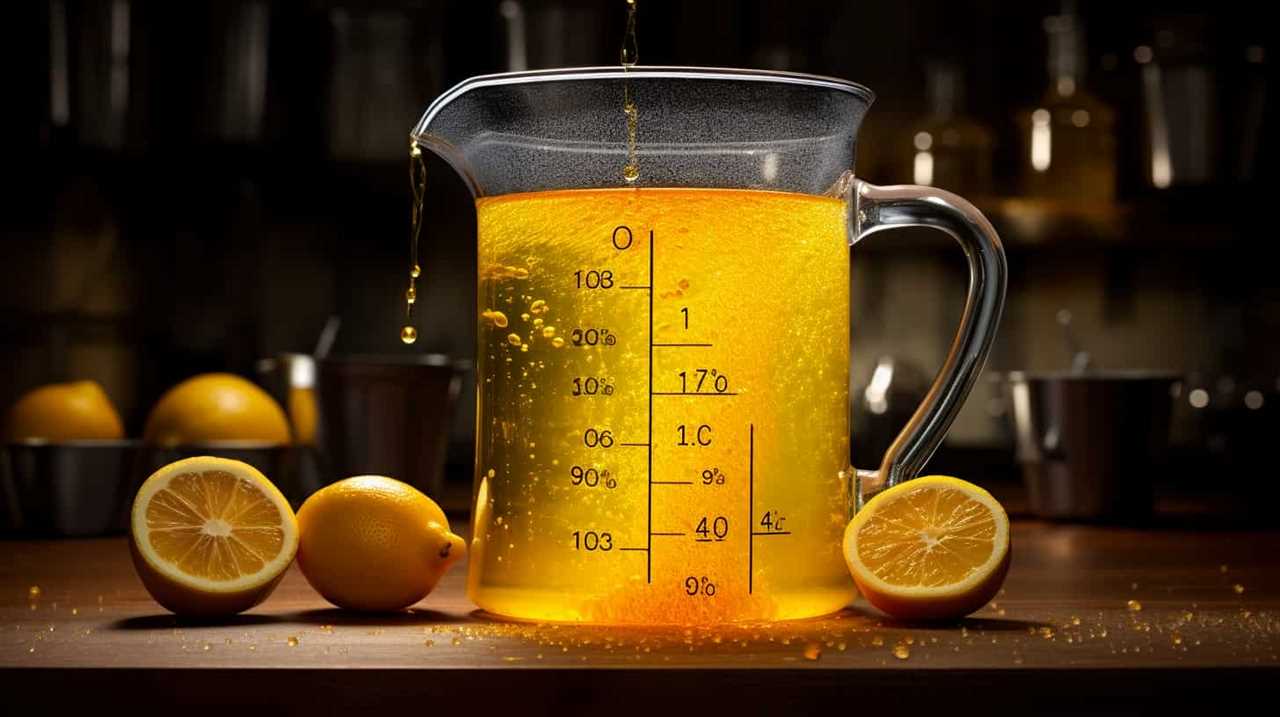
It’s important to note that while some natural variations in scent can occur due to the specific variety of oranges used, any strong or unpleasant smells should raise concerns. If you have citrus fruit allergies, it’s especially important to pay attention to the smell of orange juice, as it could indicate the presence of spoilage or contamination.
Ensuring the quality of orange juice is essential as it’s a popular beverage known for its health benefits, including being rich in vitamin C and antioxidants.
Off Taste of Orange Juice
Our taste buds can detect even the slightest hint of an off taste in orange juice, which can indicate that it has gone bad. The taste of orange juice should be fresh, tangy, and slightly sweet. If it tastes sour, bitter, or fermented, it’s likely spoiled.
One common cause of an off taste in orange juice is the use of overripe oranges. When oranges become overripe, their flavor profile changes, resulting in a less pleasant taste. Another factor to consider is the expiration date. Orange juice that has passed its expiration date is more likely to develop an off taste. It’s important to check the expiration date before consuming orange juice to ensure its freshness and quality.
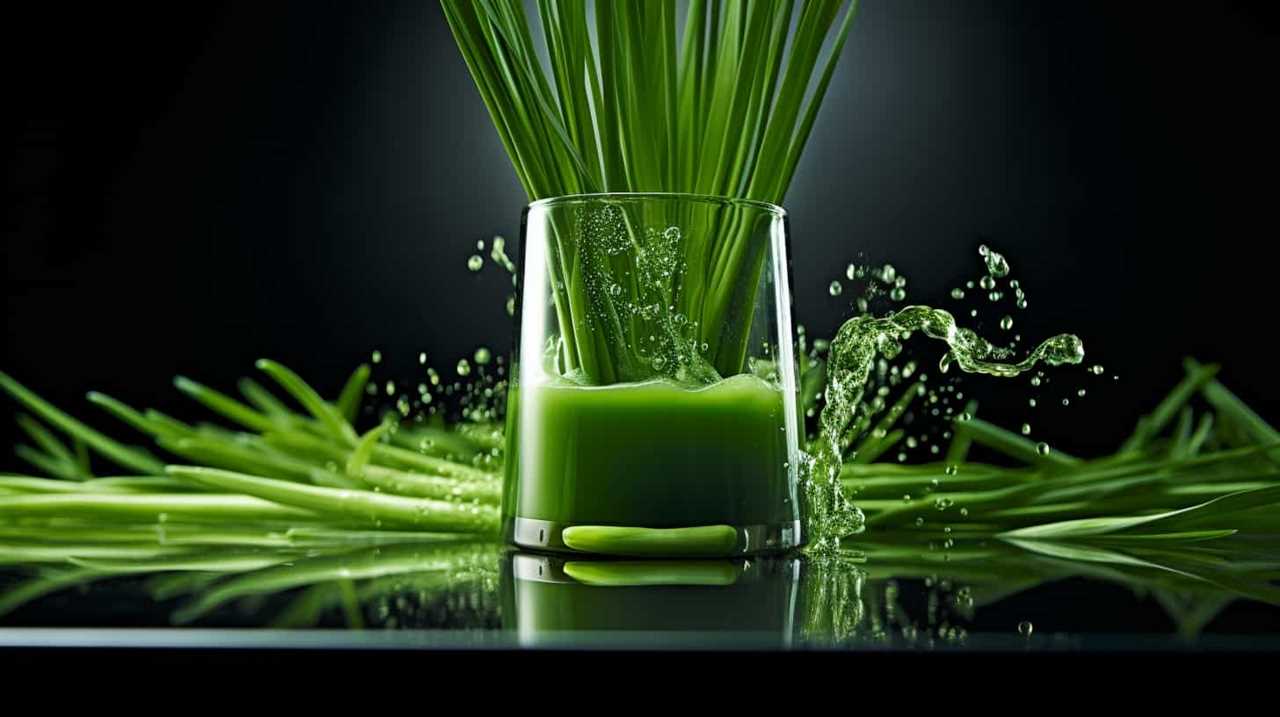
Now, let’s move on to discuss the texture changes in orange juice.
Texture Changes in Orange Juice
As we explore the texture changes in orange juice, it’s important to note that certain factors can cause it to become thicker or develop sediment. One common texture change in orange juice is pulp separation, where the pulp separates from the liquid and settles at the bottom. This can occur naturally over time, as the pulp particles become denser and sink.
Another factor that can affect the texture of orange juice is the expiration date. As orange juice ages, it may start to develop a thicker consistency and even form sediment. This is a result of the natural breakdown of the juice’s components. Therefore, it’s crucial to check the expiration date on orange juice and consume it before it reaches its expiration date to avoid any undesirable texture changes.
Mold or Growth in Orange Juice
We need to be aware of the possibility of mold or other growth occurring in orange juice. Mold can develop in orange juice if it isn’t stored properly or if it has passed its expiration date.
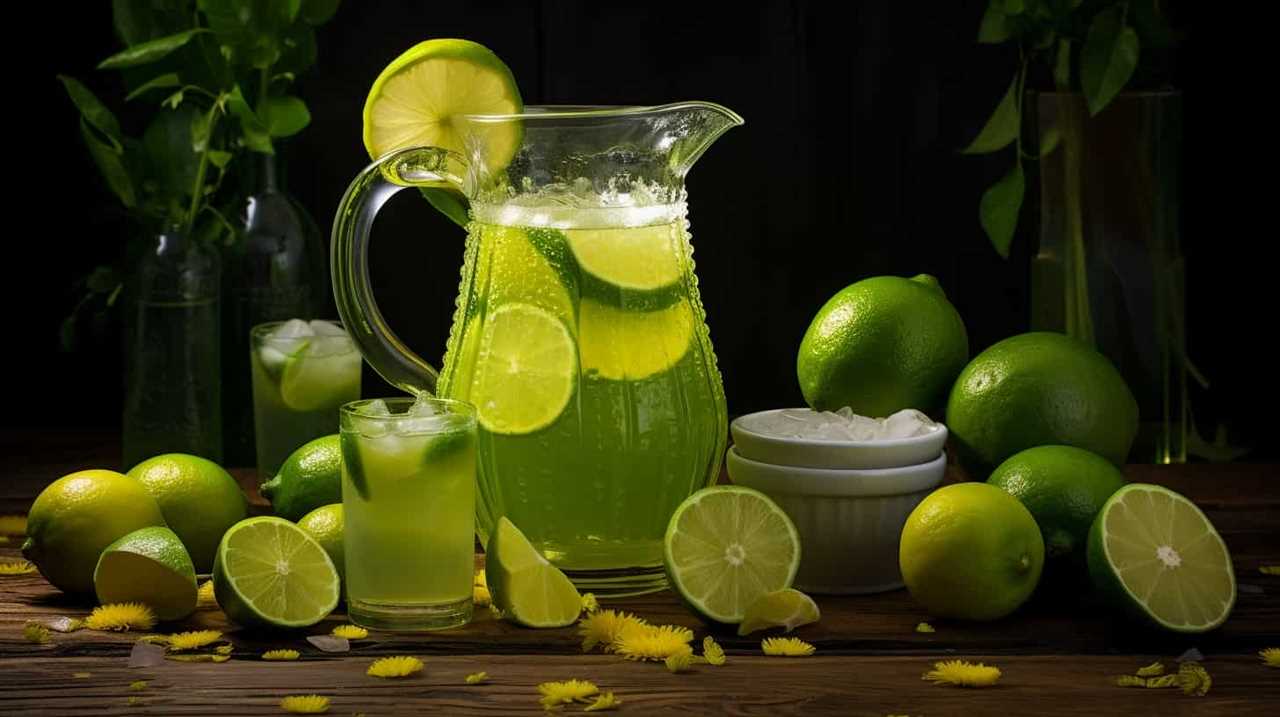
To prevent mold growth, it’s important to follow these steps:
- Store orange juice in the refrigerator at a temperature below 40°F (4°C).
- Check the expiration date on the bottle before consuming. Discard any orange juice that has expired.
- Keep the container tightly sealed to prevent air and moisture from entering, as these can promote mold growth.
Regularly inspecting orange juice for any signs of mold or unusual growth is essential. If you notice any discoloration, a strange odor, or visible mold, it’s best to discard the juice to avoid any potential health risks.
Frequently Asked Questions
Can Orange Juice Go Bad if It’s Stored in the Freezer for Too Long?
Frozen orange juice can potentially lose its nutrients and change its taste if stored in the freezer for too long. It is important to check for signs of spoilage before consuming it.
How Long Can Orange Juice Stay Fresh in the Refrigerator Once It’s Opened?
Once opened, orange juice can stay fresh in the refrigerator for about 7-10 days. To maintain its freshness, store it properly by keeping it tightly sealed and at a consistently cold temperature.
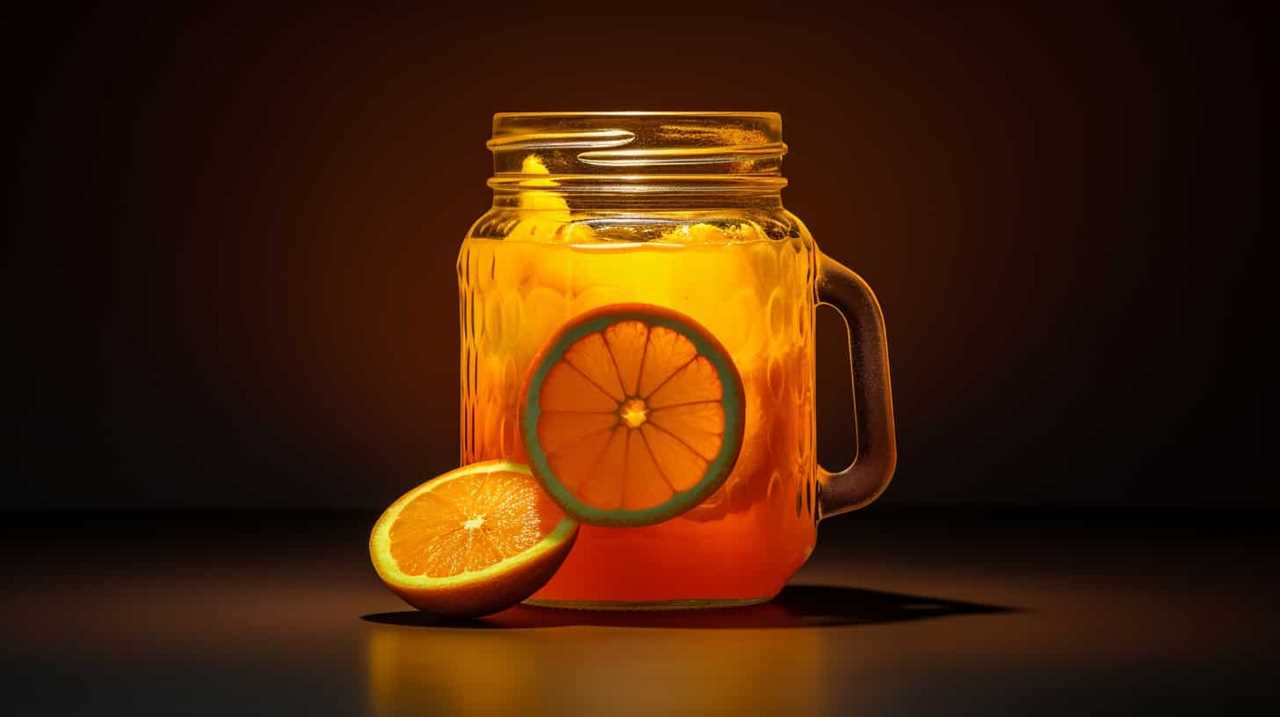
Is It Safe to Consume Orange Juice That Has Been Left Out at Room Temperature Overnight?
Left out orange juice may not be safe to drink as it can harbor harmful bacteria. Signs of spoiled orange juice include a sour smell, mold growth, and a change in color or taste.
Can Orange Juice Develop Harmful Bacteria if It’s Past Its Expiration Date but Still Looks and Smells Fine?
Orange juice can cause food poisoning if it develops harmful bacteria, even if it looks and smells fine. Signs of spoiled orange juice include a sour smell, mold growth, and a change in color or taste.
Does the Nutritional Value of Orange Juice Decrease as It Starts to Go Bad?
As orange juice goes bad, its nutritional value decreases. The longer it sits on the shelf, the more nutrients it loses. Signs of spoilage include a sour smell, off taste, and mold growth.
Conclusion
In conclusion, determining if orange juice is bad requires careful observation of color changes, strange smells, off taste, and texture changes. Just like a detective investigating a case, we must rely on our senses to detect any signs of spoilage.
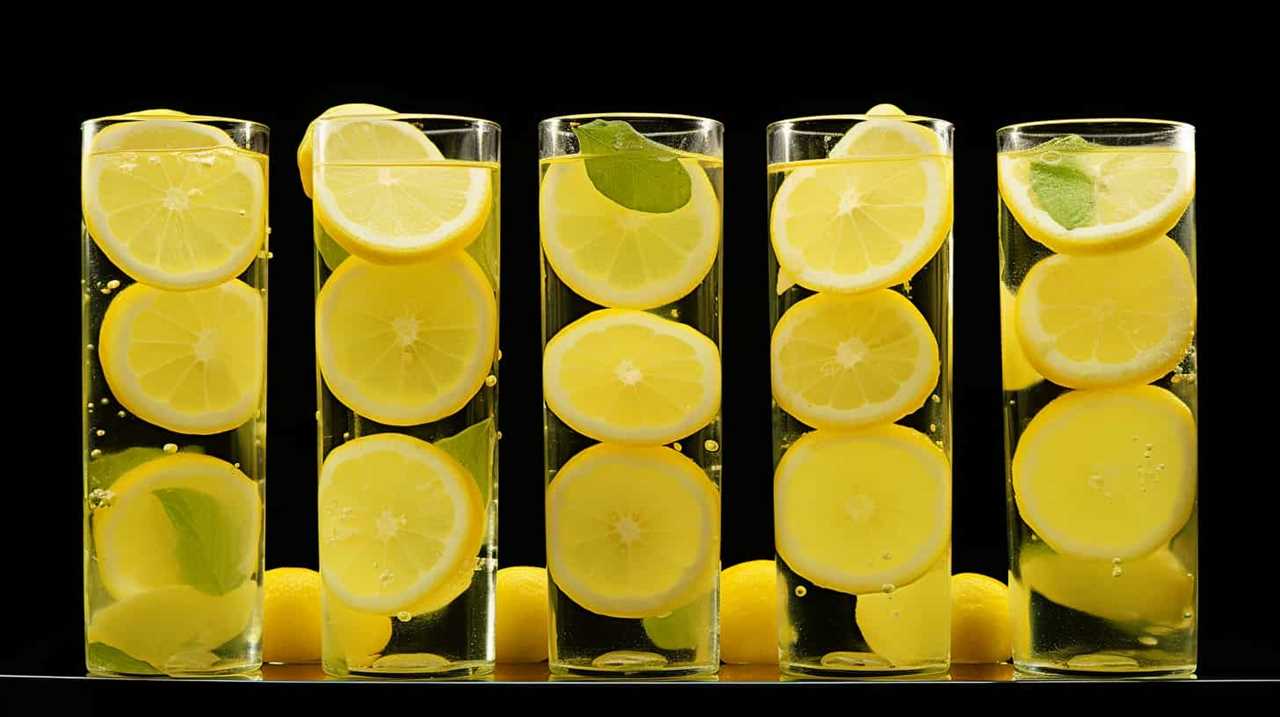
If we detect mold or growth in the orange juice, it’s a clear indication that it’s no longer safe to consume. By remaining vigilant and attuned to these indicators, we can ensure that our orange juice is always fresh and enjoyable.
Susannah expertise lies in researching and compiling evidence-based content on juicing, nutrition, and overall health. She is committed to ensuring that The Juicery World offers accurate, up-to-date, and trustworthy information to empower readers to take control of their health. Susannah’s goal is to inspire individuals to embrace juicing as a way to nourish their bodies and live their best lives.
-

 Juice Tips and Tricks3 months ago
Juice Tips and Tricks3 months agoHow To Make Homemade Pickle Juice
-

 Juice Tips and Tricks3 months ago
Juice Tips and Tricks3 months agoHow Much Lemon Juice Is Equal To Half A Lemon
-

 Juice Tips and Tricks3 months ago
Juice Tips and Tricks3 months agoHow Much Lemon Juice Concentrate Equals One Lemon
-

 Juice Tips and Tricks2 months ago
Juice Tips and Tricks2 months agoHow Long Can You Drink Orange Juice After The Expiration Date
-

 Fruit Juice Varieties2 months ago
Fruit Juice Varieties2 months agoTop 11 Most Loved Fruit Juice Varieties
-

 Juice Tips and Tricks3 months ago
Juice Tips and Tricks3 months agoHow Much Lemon Juice Is Equivalent To 1 Lemon
-

 Juice Tips and Tricks3 months ago
Juice Tips and Tricks3 months agoHow Much Lemon Juice Is Equivalent To One Lemon
-

 Organic and Natural Juices2 months ago
Organic and Natural Juices2 months ago8 Best Organic Brands for Fruit Juice




